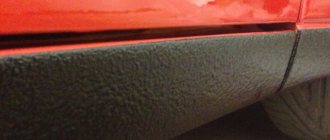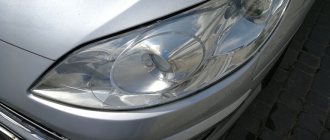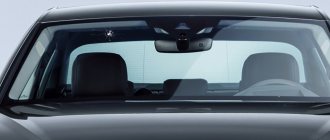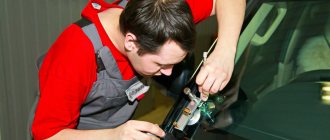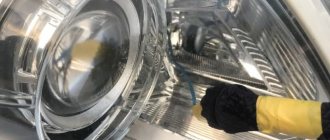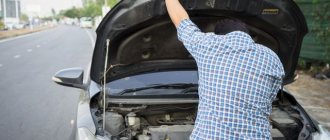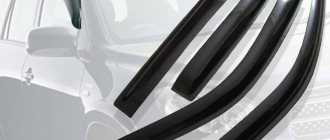The service of windshield repair is very popular in car services. It is not surprising, because an accidental hit of a pebble from the road while driving quickly often results in chips, cracks and even holes. Sometimes you have to completely replace your car glass, but in some situations it can be repaired.
The windshield adhesive must be reliable and of high quality so that it can not only hold the structure, but also ensure the tightness of the connection.
Purpose and main characteristics of sealants
Glass sealants are used for installing or repairing glass, as well as headlights and decorative elements. They are used where it is impossible to attach the part in any other way, and the finished seam will not be afraid of vibration, temperature changes and contact with moisture. The main task of the compositions is to firmly connect the parts and seal the joints so that moisture and air do not penetrate into the interior. This is a prerequisite for safe driving: when condensation appears, the view of the road is greatly impaired.
Car windshield replacement
A good glass sealant is characterized by the following properties and technical parameters:
- time until polymerization is completed - 1-24 hours;
- the approximate period before the initial setting of the composition is from 15 minutes, until a durable film is formed - up to 30 minutes;
- density - 102-1.35 g/cubic. cm;
- operating temperature - from –40 to +90 degrees;
- shrinkage - no more than 1%;
- consistency - thick, pasty;
- elasticity - high;
- Possibility of application on old sealant.
With the help of a suitable composition, you can glue the glass yourself in a minimum period of time and start using the machine on the same day.
Padding
Experts do not recommend applying the component to the remains of old glue. Primer compositions are applied in one layer using a brush or a supplied swab. The component is applied directly to the place of gluing and to the glass itself where there will be contact with the groove.
This also includes treatment with an activator. The composition will help to effectively and completely remove all that remains of the old glue.
Types of automotive glass adhesive
Not every composition from the first store you come across is suitable as a glass glue-sealant. For example, ordinary superglues are not suitable for this purpose - they do not have the required degree of elasticity, so the seam will quickly deteriorate from regular vibration. To eliminate damage to glass, you should also choose a special glue that:
- will not cause a decrease in glass transparency;
- eliminates the appearance of unsightly spots;
- will “freeze” the crack, preventing its expansion and spreading.
A good sealant for auto glass is able to accommodate vibrating substrates, which, in addition, are constantly exposed to ultraviolet radiation, detergents, moisture, wind, and temperature changes. There are different types of glue, selected by users depending on the problem encountered.
For glass installation
Glass bonding compounds have replaced outdated rubber gaskets. Typically, such products are prepared on a polyurethane basis, so the structure will be completely sealed, while the seam will remain elastic. Safety for passengers is maximum - even in an accident, the glass will not fly out.
Sealants may also have a different base - other artificial resins, silicone (rubber). In any case, before purchasing, you need to make sure that they are suitable for working with glass, and also purchase a primer to enhance the adhesion of dissimilar surfaces and improve the protection of the seam from ultraviolet radiation. The electrical conductivity of the sealant should be low or absent so that the car owner does not suffer from static electricity.
To eliminate defects on glass
Repair (optical) sealant is an automotive product that allows you to seal a crack or repair a chip on a windshield or other glass. After hardening, the seam formed by it follows the structure of the base, so the sealant is almost invisible. The main properties of such a product are given below:
- high degree of transparency after polymerization;
- good fluidity, rapid penetration into even the smallest defects;
- resistance to moisture, ultraviolet radiation;
- no stains, darkening or yellowing over time.
Typically, sealants for auto glass repair are sold complete with the necessary accessories - tape, a blade, a needle for cleaning dirt from the crack, and a degreaser. Using such tools is not difficult, and repairs can be done with your own hands.
Adhesive for windshield cracks: how to choose, glass repair, tips
Small cracks in the windshield may not interfere much with your visibility. But over time, due to temperature changes, increased vibration, and high humidity, small spider webs of chips turn into a significant problem. Therefore, there is no point in delaying the elimination of minor defects. Windshield adhesive for repairing cracks can help make minor repairs easier.
Types of adhesive for car glass
It is possible to correct the defect without resorting to the services of a car repair shop for glass replacement. You can seal a crack in your windshield with your own hands. For this, organic resins and synthetic polymer components are used.
Auto repair adhesive is used: to secure and mount the entire front glass or to repair chips and cracks on it. In the first case, a flexible connection is created, which makes it possible to compensate for deformation vibrations. The composition must meet the following requirements:
- Heat and moisture resistance.
- Create an airtight coating.
- Form a seam that is resistant to prolonged vibration and aggressive environments (windshield wipers, icing, intense pollution).
- Average setting speed.
- Low viscosity (to penetrate micro-chips).
- Transparency.
The following compounds are suitable for eliminating cracks and chips:
- Glass balm: "Canada balsam" . It is a solid transparent material that consists of organic resin. Firmly holds the fragments together and does not crystallize. Heating is required to use it. Time until complete drying is 48 hours.
- Silicone adhesive: Done Deal DD6705 . A synthetic composition that has high adhesive properties. Has a wide operating temperature range. Provides reliable fastening of materials.
- Acrylic glue: Master Teks . Suitable for repairing cracks and sealing chips. Creates a flexible layer after drying.
- Ultraviolet glue: UV SM 510 . The connection is not damaged even if the glass breaks. Exposure to a UV lamp is required for activation and setting.
If it is not possible to immediately seal the damage, use tape. This will prevent the schism from spreading further for some time.
How to prepare glass for repair
Before starting to eliminate defects, the surface requires pre-treatment. To do this you need:
- Vacuum the damaged area and wipe with a damp, clean cloth on both sides.
- Degrease the work area using alcohol or acetone.
- Warm up with a hairdryer. This is necessary to remove possible residual moisture and heat the surface to a temperature of 12–15 ⁰C.
Work to eliminate splits should be carried out in a heated, dry room with forced ventilation and no sunlight. Temperature not lower than 10 ⁰С.
Required Tools
To repair chips and other damage to the windshield, prepare the following tools:
- Drill with a thin drill bit.
- Strips of transparent film are 1–2 cm longer than the damage.
- Medical syringe with a needle.
- Blade for removing excess glue.
- Clean napkins made of non-woven material.
- Polymer resin or glue.
Windshield Crack Repair
To prevent damage from spreading further during the work, remove excess stress. To do this, step back 2-3 cm from each end of the split and drill small recesses from each edge (not through).
- Apply repair compound generously to the film strips along the entire length.
- Using a syringe, fill the crack with polymer adhesive material from bottom to top in one direction. Pump it under pressure into the drilled holes.
- Apply film to the surface of the defective area of glass and carefully smooth it out. Remove excess glue immediately with a clean napkin.
- Place the UV lamp at a distance of 10–15 cm. Leave to act on the resin for 25–35 minutes. If there is no special lamp to initiate the clutch reaction, move the car under sunlight.
- After the composition has completely set, remove the film and remaining glue using a blade.
Avoid the formation of air bubbles. If this happens, try to push them out using pressure. If the polymer material quickly adheres, try heating it slightly with a lighter.
We recommend watching a video about crack repair:
Depending on the chosen polymer composition, it takes from 10 to 48 hours for complete curing. During this time, operation of the vehicle is not permitted.
Finally
The right composition for repairing a windshield will help you reliably and easily repair damage, without replacing the entire windshield. Follow the instructions strictly and share your experience in the comments and social networks.
Types of automotive sealants
To avoid the penetration of dirt, water, and air into the car interior, you need to buy only the highest quality sealant when gluing or repairing glass. Depending on the composition, there are different types of products.
Silicone
Such products are created on the basis of artificial rubber (silicone), therefore they are highly elastic and are not afraid of vibration. After hardening, the sealants form a durable rubber-like gasket. They reliably seal windshields and other glass, and are also suitable for repairing windows and skylights.
Most often, silicone sealants are used to seal cracks up to 4-6 mm deep. They are liquid, fluid, and penetrate even the smallest gaps. The sealed seam can be heated up to +250 degrees without damage or reduction in performance characteristics. The disadvantage of the compositions is their poor resistance to oils and alkalis.
Highly fluid agents are used to repair chips
Polyurethane
The adhesion to surfaces of such products is even higher than that of silicone sealants. They are made on the basis of polymers of the urethane group - resins of synthetic origin, due to which they have excellent elasticity, do not crack from vibration, and are not afraid of mechanical damage. Polyurethane sealants also boast the following properties:
- resistance to moisture, ultraviolet radiation, chemicals;
- no harm to metals (do not cause corrosion);
- fast curing;
- optimal consistency, sufficient fluidity;
- high tensile strength.
The disadvantage of a number of one-component polyurethane sealants is their maximum operating temperature - it is up to +100 degrees. Two-component formulations tolerate higher temperatures.
Anaerobic
Sealants that harden in an airless environment tend to retain their plasticity in air for a long time. This makes it easy to work with them even without the knowledge of gluing car glass. After curing, the anaerobic composition is transformed into a durable plastic-like substance that does not expand or dry out during use, and retains its properties at temperatures ranging from –50 to +175 degrees.
Heat resistant
Such sealants are extremely resistant to high temperatures - they can easily withstand heating up to +375 degrees. In addition, heat-resistant sealants do not deteriorate from the influence of vibration, loads, chemicals and ultraviolet radiation. They are usually sold in the form of pastes, powders or aerosols. The first two options require the presence of a hardener (they are two-component) and before use they must be diluted in a certain proportion.
Application Tools
The DIY repair kit includes all the necessary tools. Additionally, the following materials may be needed:
- textile;
- mirror;
- drill with a sharp drill bit;
- flashlight or bright lamp;
- blade;
- transparencies.
When purchasing glue separately from the kit, you will additionally need:
- syringe;
- degreaser;
- frame with suction cup;
- dispenser;
- needle, awl.
When purchasing items separately, it is important to read the instructions first to ensure compatibility. It is best to select a degreaser and activator for two-component adhesive from the same manufacturer.
If the glass cracks in bad weather, the damage must be sealed with tape to avoid contamination of the break.
To save time, you should buy ready-made kits for repairing chips, which contain everything you need for independent work.
Rules for choosing glue for glass repair
If the composition is selected for automobile glass, it should not just mask defects, but fill them, while “eating” into the surface. The sealant must show optimal elasticity, shock-absorbing ability and resistance to vibration. You should not choose products that dry literally in minutes - the longer the polymerization process lasts, the more reliable the finished seam will be. In addition, quickly crystallizing compositions are difficult to work with, and it will be difficult to cope with them without skill.
To glue car glass, you need to choose a sealant of higher density - compositions that are too fluid are inconvenient to work with and are more suitable for sealing cracks. When purchasing a material, you should also take into account the indicators of elasticity, resistance to mechanical loads and deformations, vibration and shear. High-quality sealant does not fade or turn yellow from exposure to sunlight, and does not deteriorate from humidity or direct and regular contact with water.
Preparing a place for new glass
Using a construction knife, cut off the remaining glue. The rubber molding will fail, so it is important not to forget about it when purchasing glass. When everything is cleaned off, a new element is applied to the place. If necessary, make small notes with a marker or felt-tip pen during fitting.
Some car models have stops that will prevent the glass from being installed incorrectly. If there is no stand, then you should prepare a place on the hood. It must be covered with rags or large cardboard.
Advantages of adhesive sealant
A good sealant is ideal for base materials (glass, plastic, metal) and does not cause damage. It also has a number of other advantages:
- plasticity - under the influence of temperature changes, the glass location parameters can change, and the sealant can easily adapt to them without losing its integrity;
- elasticity - the seam absorbs some of the vibration and shock loads, smoothes out sharp “jumps” of the car while driving, ensuring safety for the glass elements of the car;
- optimal curing speed - the owner does not have to wait several days to start using the machine again - usually the sealant takes less than a day to completely polymerize;
- ease and convenience of work - even a novice craftsman can glue the glass if the instructions are strictly followed.
Which brand of polymers should you buy?
Even knowing the required polymer density, making the right choice can be very difficult. The market for materials for auto glass repair offers a truly huge range of polymers from a variety of manufacturers. And mostly from American manufacturers. We invite you to check out the best of them:
Delta Kits
An American manufacturer offering a full range of auto glass repair products, including acidic and acid-free polymers. Please note: all polymers from this manufacturer are transparent.
Equalizer
Another American company that specializes in the production of high-flow polymers with a density of 10-40 cPs. All Equalizer products are medium acidity polymers.
Glass Technology
Once again, a manufacturer from America with an impressive selection of equipment and materials for auto glass repair. Glass Technology produces polymers of different densities, which are acid-free and transparent.
Poly-lite
An American brand known for a large assortment of acidic polymers of different fluidity, including both transparent and colored products.
A special feature of Poly-lite is the development of a special primer polymer that is used to repair long cracks in glass.
Antiskol
A Russian company that offers customers several types of polymers with densities of 30, 60, 200 and 600 cPs. It is noteworthy that Antiskol does not have completely transparent polymers - they all have a brown tint. Other well-known and popular brands include Dymaxis, Glass Mechanix, Tri Glass and many others.
Which sealant is better
When choosing a product, you should pay attention not only to its parameters, but also to the popularity of the brand: it is not recommended to buy the cheapest, untested formulations.
SikaTack Drive
A distinctive characteristic of the sealant is its suitability for any glass of trucks and cars. The product is available in 310 ml tubes, used without preheating at temperatures of about +20...+22 degrees, hardens in 4 hours.
3M Windo Weld SuperFast Urethane
The sealant does not require the use of a primer, since it itself is quite durable and is not afraid of ultraviolet radiation. It can even be used on the windows of racing cars and vehicles that are often driven off-road. After application, the product begins to set in 15 minutes, complete crystallization occurs in 8 hours.
Dow Automotive Betaseal 1527
The set of accessories for making a sealing seam includes a primer - it is mandatory for use with this composition. The product has the following properties:
- low electrical conductivity;
- initial setting in 12 minutes;
- highest strength;
- suitability for all types of transport;
- Possibility of application at +5 degrees and above.
After gluing the glass, you can use the machine within an hour (in emergency situations), so the product is considered one of the fastest-drying glass adhesives.
Dow Corning 7091
This silicone-based composition is widely used when replacing glass, since it has excellent adhesion to metal and plastic, is characterized by high elasticity, strength, and works at –55...+185 degrees. Typically, white sealant is used for glass installation, although black and gray products are also available for sale.
The composition of this brand is available in a standard 310 ml tube, as well as in 20 liter and 250 kg cans (for industrial use). It hardens in 3 hours and does not require priming or heating during application.
3M PU 590
The product is considered universal, suitable for working with a variety of surfaces - glass, metal, wood, plastics. It sets in 25 minutes, dries completely in 4-8 hours, and does not require the use of a primer. The disadvantages include the risk of cracks and crumbling when heated above +100 degrees.
Abro WS 904
A sealant under this name is highly valued by professionals and is considered one of the leaders on the market. Sold in the form of a rolled tape, it is easy to use, does not stick to your hands, and has a high degree of adhesion and plasticity.
Donedeal DD6870
The product has a high degree of transparency, is invisible on glass, and can be used to repair other parts of the car. The characteristics of the sealant are as follows:
- temperature during operation - from +5 to +30 degrees, temperature range during operation -45...+105 degrees;
- connection strength - 195 kg/sq. cm;
- initial setting time - 1 hour, period until complete polymerization - 24 hours.
The sealant is well suited for gluing materials with different coefficients of thermal expansion - plastic, glass, plexiglass, rubber, metal. It does not deteriorate from vibration, mechanical stress and the action of chemicals.
"Efimastica RV"
A one-component polyurethane sealant is used in conjunction with the primer that comes with the kit. It forms a very strong connection between glass and metal, plastic, and completely hardens within 24 hours, although it forms the initial film in 30 minutes. The seam can be used at temperatures from –40 to +80 degrees and has high tensile strength (6 MPa).
Teroson PU 8590
This sealant is also prepared on the basis of polyurethane and is widely used for gluing auto glass not only in passenger cars, but also in trucks, buses, and railway cars. Requires prior application of primer. It sets in half an hour, dries in 4-6 hours. It is UV resistant, wear-resistant, and holds the glass securely immediately after insertion.
Merbenit SK212
The product based on modern MS polymers boasts the highest tensile strength and is even used in shipbuilding. The sealant does not need a primer or heating, it is resistant to vibration, loads, ultraviolet radiation, protects the metal from corrosion, and can be painted even in a semi-hardened form.
Liqui Moly Liqui Fast 1400
Polyurethane sealant of this brand is used for gluing any car glass; it cures in a short time under the influence of moisture. It has good elasticity, elasticity and strength.
The best manufacturers
The final result of the repair, as well as masking the defect, depends on the manufacturer.
Glass polymers with the best performance are produced by the following manufacturers:
- First Glass;
- Henkel;
- Done Deal;
- 3M.
A series of materials from Henkel is produced under the Terostat brand. The brand has a wide range of liquids and kits for repairing mirrors, glass, and plastic. Due to the powerful polymer base, the compositions in this series quickly crystallize, have excellent transparency and withstand any weather conditions.
Instructions for use
The room for working with adhesive-sealant should have a positive temperature (most manufacturers recommend that it should not drop below +5 degrees, optimally above +15 degrees). The car must be in a static state for an hour.
Before work, wear safety glasses and gloves. It is advisable to try gluing the windshield yourself, and only after that try to install the rear or side windows, which is much more difficult. The procedure is as follows:
- the old glue is not removed, but cut to a thickness of 2 mm with an even cut;
- if required by the manufacturer, the product is preheated;
- glue is applied to the surface using a mechanical gun or pneumatic gun in a uniform strip without thickening or breaks;
- While it hardens, fix the glass with masking tape;
- lower the side windows of the car and leave it to dry.
Until the sealant has completely hardened, you should not slam car doors, or frequently open and close the gates of the room where it is located. The car should not be washed within 48 hours after gluing.
Criterias of choice
When purchasing a glass sealant adhesive, it is also worth looking at how to apply it. We have many options to choose from. The most popular solution is undoubtedly glue in a tube. Unfortunately, if it doesn't have an applicator, pressing too hard on the package can result in an uncontrolled flow of glue.
Auto glass sealant with brush is also available in the market. This makes application easier and allows the adhesive to penetrate even hard-to-reach areas. Spray adhesives have become very popular recently. They ensure uniform, fast and problem-free distribution of the drug over the surface, and thanks to a special valve they provide vertical and horizontal application. Glass glue can also be applied with a hot gun. This increases the strength of the weld.
When deciding to purchase glass glue, you should also pay attention to the reputation of the manufacturer. The more satisfied users are, the more we can assume that a given product is highly effective.
How to remove old sealant
If you need to get rid of improperly applied or lost sealant, you can heat it with a hair dryer. When heated, the material softens and is easily removed from the base. The remaining product is removed with a knife, but you must act carefully so as not to scratch the body. If necessary, you can dissolve pieces of the product with diesel fuel or white spirit.
Working with automotive sealants is simple and does not require special knowledge. If necessary, you can buy a glass gluing agent and carry out all the steps yourself - then you can save money, but not lose quality!
Classification of auto sealants
The maintainability of different materials is not the same, and to varying degrees. Glass in this case stands apart. The reason is known - the specific physical properties of this material, primarily its fragility. Transparent plastic, used as an alternative to glass, is more affordable in this regard; gluing its individual parts together is not a problem. But the feasibility of such an operation is questionable - plastic optics are much cheaper than glass ones. However, broken glass and plastic headlights can be repaired using waterproof adhesives called sealants. They are characterized by their ability to provide a high-quality and durable connection of the bonded surfaces due to excellent adhesive properties, guaranteeing ideal sealing of the seam against moisture and air.
But the choice of sealant for car headlights is complicated due to the presence of several varieties. Moreover, many compositions are universal, capable of gluing most other materials used in the automotive industry, from wood and metal to leather.
But we are interested in glass. It all depends on the physical and chemical properties of a particular sealant. However, “straight” hands won’t hurt either - the lack of perfect tightness of the treated seam means that moisture and air - the main components of the metal oxidation reaction - will inevitably get inside the optical device. In addition, due to the higher temperature inside the headlight, this moisture will settle on the surface in the form of condensation, significantly degrading the quality of lighting.
So what sealant should you use to glue car headlights? Below we will consider this issue in more detail, but for general development, we note that one-component compositions are the most common. In retail sales they are present in a form that is almost completely suitable for immediate use without the need to perform any complex manipulations. If you purchase sealant in the form of a thick liquid, in most cases the packaging container is equipped with a dispenser. Adhesive compositions in paste form require dilution, while the necessary liquid is included, there is no need to buy it separately.
There are four main groups of sealants, differing in their component composition: silicone, polyurethane-based, heat-resistant, and anaerobic. Let's consider their features, characteristics, disadvantages and advantages.
